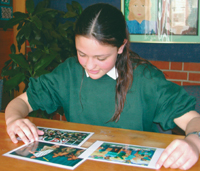|
SOCIAL STUDIES — TIKANGA–Ä–IWI |
Students’
attitudes, interests and liking for a subject have a strong bearing
on their achievement. The Social Studies survey sought information from
students about their curriculum preferences and perceptions of their
own achievement. The survey was administered to the students in an independent
session (four students working individually on tasks, supported by a
teacher).
The survey included twenty-one items which asked students to record
a rating response by circling their choice, and two items which invited
students to write comments. The results of the latter two items are
not reported here.
Favourite subjects
The students were first asked to select their three favourite school
subjects from a list of twelve subjects. The results are shown adjacent.
|
PERCENTAGES
OF STUDENTS RATING SUBJECTS AMONG THEIR THREE FAVOURITE
|
%
responses |
| GEd |
MI |
| Subject: |
|
|
Physical
Education |
69 |
68 |
Art
|
53
|
43 |
Technology
|
40
|
26 |
Mathematics
|
26 |
47 |
Music
|
26 |
13 |
Mäori
|
20
|
28 |
Science
|
18 |
17 |
Social
Studies |
13
|
13 |
Reading
|
10
|
13 |
Writing
|
7
|
13 |
Speaking
|
6 |
9 |
Health
|
1 |
2 |
|
Physical
education was the most popular subject for both groups. For Mäori
students in general education, art came next, followed fairly closely
by technology and more distantly by mathematics and music, then Mäori
and science. Students in Mäori immersion settings placed mathematics
much higher, just ahead of art, with only Mäori and technology among
the other subjects showing substantial popularity. Social studies came
lower on both lists, but this may be misleading because social studies
is often embedded in theme work and not easily identified as social studies.
Rating items
Five of the twenty-one rating items were previously used in the 1997 Social
Studies survey. Responses to these five items are presented below. |
| Compared
to Mäori students in general education, students in Mäori
immersion settings were much more positive about doing social studies
at school, doing more social studies at school, and learning or doing
more social studies as they got older. There was not as much difference
on questions 3 and 5, looking at the amount learned and how often the
class did “really good things in social studies”.
 |
 |
| |
The remaining 16
questions were really two parallel sets of eight questions. The first
set asked about student enjoyment of eight aspects of social studies,
while the second set asked about the frequency with which school programmes
focused on these eight aspects. The results are presented in the table
below.
Students showed very positive attitudes to learning in most of the listed
aspects. Mäori students in general education were particularly
interested to learn about “living in the future”, with 67
percent choosing the highest rating, but four other aspects had more
than 30 percent of students choosing the highest rating. Students in
Mäori immersion settings were even more positive, with more than
30 percent of students choosing the highest rating on six of the eight
aspects. Compared to Mäori students in general education, students
in Mäori immersion settings were substantially more positive about
two aspects (the way people work together and do things in groups, and
the work people do and how they make a living), and substantially less
positive about one aspect (how people lived in the olden days).
Students were then asked to rate how often they learned about each aspect
in social studies at school. In general, students in Mäori immersion
settings gave higher ratings, with seven of the eight aspects having
more than 50 percent of students using the ratings “heaps”
and “quite a lot” (compared to just two aspects for Mäori
students in general education). Students in Mäori immersion settings
gave much higher ratings for two aspects (the work people do and how
they make a living, and living in the future), and slightly lower ratings
for just one aspect (what is happening now – in New Zealand and
other countries).
|
